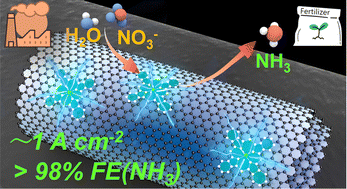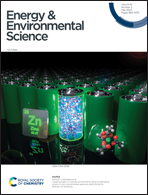Molecular electrocatalysts for rapid and selective reduction of nitrogenous waste to ammonia†
Abstract
Electrocatalysis of the nitrate (NO3−) reduction reaction (NO3RR) or nitrite (NO2−) reduction reaction (NO2RR) is a sustainable route for removing nitrogenous pollutes and producing ammonia (NH3). Developing electrocatalysts that can exhibit high NH3 selectivity at high current densities is important for their practical applications, but still remains challenging. Here we demonstrate that molecularly dispersed electrocatalysts (MDEs) of metal phthalocyanines on carbon nanotubes can enable rapid and selective NH3 production from the NO3RR and NO2RR. The copper phthalocyanine (CuPc) MDE shows a much lower overpotential requirement for the NO3RR than the aggregated CuPc sample, delivering a high NH3 partial current density of ∼1 A cm−2 with a faradaic efficiency (FE) of NH3 over 98%. Due to the favorable NO3− absorption, the cobalt phthalocyanine (CoPc) MDE shows higher activity than the CuPc MDE for the NO3RR, but FE(NH3)s of the CoPc MDE at high current densities are limited by its enhanced hydrogen evolution activity. It is further found that the CoPc MDE is more active in the NO2RR than in the NO3RR, which is opposite to the CuPc MDE. Thus, the CoPc MDE employed for the NO2RR can overcome the limitation of the hydrogen evolution reaction, showing a high NH3 partial current density of 466 mA cm−2 with FE(NH3) >97%.



 Please wait while we load your content...
Please wait while we load your content...